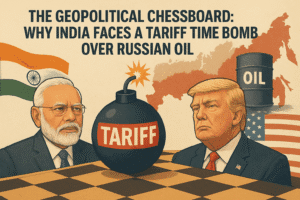The Geopolitical Chessboard: Why India Faces a Tariff Time Bomb Over Russian Oil
The outcome of Friday’s Trump-Putin peace talks in Alaska directly threatens India with severe economic pain. US Treasury Secretary Bessent explicitly warned that additional tariffs or sanctions will hit India if the Ukraine negotiations fail. This follows the US already imposing a crippling 50% total tariff on key Indian imports like Russian oil and weapons, set to take effect August 27th. India is caught in a bind: its necessary shift to discounted Russian crude (now 40% of imports) shields its population from inflation but infuriates Washington, derailing vital trade talks and straining relations.
These punitive tariffs, labelled near-“embargo” level, target India’s export-driven sectors like textiles and jewellery, potentially slashing national economic growth by 0.5% and causing significant job losses. While Delhi defends its energy choices as essential for its poor, the US demands alignment, highlighting India’s precarious position as collateral damage in the wider US-Russia conflict.

The Geopolitical Chessboard: Why India Faces a Tariff Time Bomb Over Russian Oil
The simmering economic tension between the US and India risks boiling over, directly tied to the outcome of high-stakes diplomacy between Washington and Moscow. US Treasury Secretary Scott Bessent issued a stark warning: additional punitive tariffs on India are likely if this week’s Trump-Putin peace talks collapse.
The Stakes on the Table:
- The Immediate Trigger: President Trump meets President Putin in Anchorage this Friday, aiming to broker a Ukraine ceasefire. Bessent explicitly stated that “sanctions or secondary tariffs could go up” on India if the talks fail.
- The Existing Pain: Earlier this month, the US imposed a crippling 50% total tariff (a 25% penalty on top of existing 25% tariffs) targeting India’s imports of Russian oil and weapons. This is a significant escalation beyond standard trade disputes.
- India’s Strategic Bind: Facing soaring global energy prices, India ramped up purchases of discounted Russian crude – rising from a mere 3% of imports in 2021 to 35-40% in 2024. Delhi defends this as essential for energy security and shielding its vast population from inflation. However, this pragmatic move severely strained relations with Washington and derailed ongoing bilateral trade talks.
- The European Angle: Bessent’s frustration extended to Europe, criticizing their “carping” about the Trump-Putin talks while failing to match US sanctions pressure. “The Europeans need to join us… be willing to put on these secondary sanctions,” he emphasized, highlighting a transatlantic rift in strategy.
Beyond the Headlines: The Human & Economic Cost:
- India’s Growth at Risk: The existing 50% tariff, set for August 27th, is described by experts as effectively an “embargo” level. It makes India the most heavily taxed US trading partner in Asia. Key export sectors like textiles and jewellery face devastation, potentially dragging down India’s GDP growth by half a percent. This translates to real job losses and economic hardship.
- Trade Talks in Peril: Negotiations, set to resume on August 25th, are already fraught. Bessent labelled India “a bit recalcitrant,” citing its refusal to lower agricultural and dairy tariffs. The new tariff threat hangs like a sword over these discussions. Trump’s focus remains sharply on reducing the $45 billion US trade deficit with India, branding it a “tariff abuser.”
- A Global South Dilemma: India’s position reflects a broader challenge for non-aligned or developing nations caught between superpower rivalries and the practical need for affordable energy. Its stance underscores the difficulty of balancing geopolitical pressures with domestic economic realities.
What Comes Next: A Fork in the Road
- Scenario 1 (Talks Succeed): A Trump-Putin breakthrough could temporarily ease pressure, potentially freezing or delaying further tariff hikes on India. Trade talks might gain fragile momentum, though core disagreements remain.
- Scenario 2 (Talks Fail): Expect rapid escalation. New US tariffs seem highly probable, further crippling Indian exports and deepening the diplomatic chill. India would face intensified pressure to slash Russian oil imports, forcing difficult choices about energy costs and inflation.
- The Wildcard: Europe’s response is crucial. If Bessent succeeds in rallying tougher EU sanctions on Russian energy buyers, India’s isolation and economic pain would multiply significantly.
The Insight: This isn’t just about trade deficits or oil contracts. It’s a high-risk geopolitical gambit where India has become collateral in the US-Russia showdown over Ukraine. The outcome hinges not only on Delhi’s negotiations with Washington but profoundly on the success or failure of talks happening thousands of miles away between two other world leaders. The livelihoods of Indian workers and the stability of key industries now depend, in part, on the unpredictable chemistry between Trump and Putin. The clock is ticking towards August 27th, making the next week critical for India’s economic trajectory.
You must be logged in to post a comment.